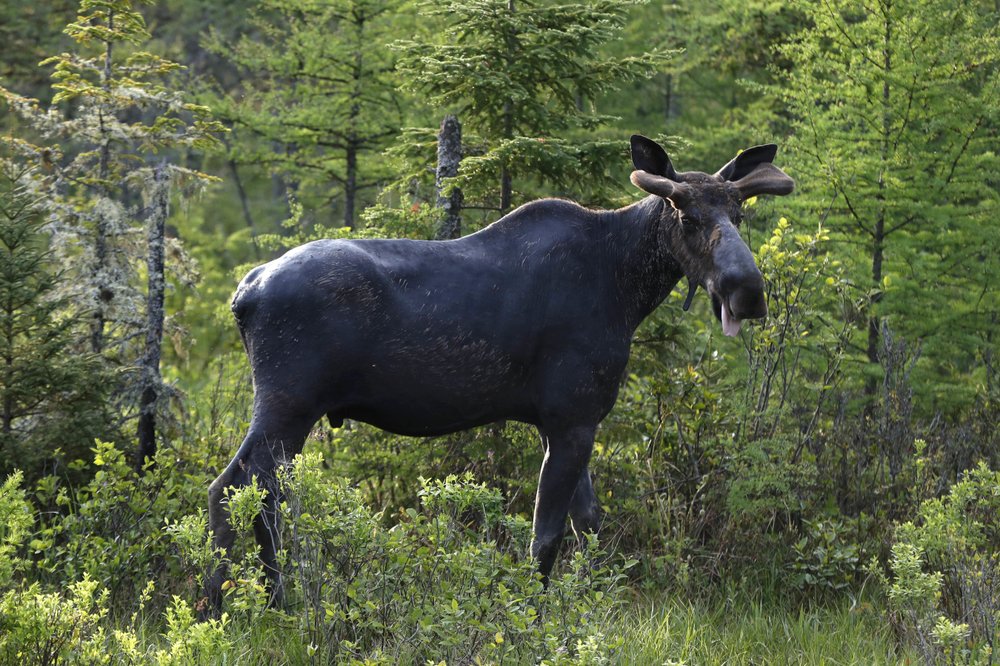ACTON, Maine (AP) — The devastating toll of ticks on New England’s moose herd has caused the region’s population to shrink, and experts worry it could get worse with climate change.
The northern New England states are home to thousands of moose, but the herd has dwindled in the last decade, in part because of the winter ticks. The ticks infest moose and suck their blood dry, and sometimes tens of thousands are found on a single animal.

Maine has the largest moose population east of Alaska and was home to some 76,000 animals about seven years ago. The herd size is commonly estimated at 60,000 to 70,000 now, but Lee Kantar, Maine’s moose biologist, said that number might be as low as 50,000.
The ticks are a worsening problem because of recent mild winters, which allow them to thrive, Kantar said. Scientists in Maine are entering the final year of a multiyear study of the moose population in its northern and western areas and have found better survival of moose calves in northern areas, which is usually Maine’s coldest corner.
“Every day that is mild in October and November and we don’t get any snow, every day ticks are out getting on moose,” Kantar said. “Climate is a factor in the level of ticks we have out there.”
The smaller moose herds of New Hampshire and Vermont have also suffered, and some estimates say those populations have dropped by half or more since the 2000s.
A 2018 study of New Hampshire and western Maine moose published in the Canadian Journal of Zoology stated that the ticks were the primary cause of a 70 percent death rate of calves over a three-year period. Vermont lost 63 percent of its collared moose calves last winter, and that is the highest figure on record, said Cedric Alexander, the state’s moose biologist.
The animals are also susceptible to deaths from other parasites and deep snows, but ticks are “the primary driver of the mortality in Vermont,” Alexander said. The ticks kill moose calves and make it difficult for female moose to have babies, said Pete Pekins, a professor of natural resources and the environment at University of New Hampshire.
“That’s the insidious part of this parasite because you’d never know, because these animals are alive,” Pekins said.
The warming climate is also bad for Maine’s annual moose hunt, which is a critical part of the economy in parts of rural Maine. State wildlife regulators have reduced the number of permits by nearly a third, to fewer than 3,000, over the past six years. The hunt, which attracts tens of thousands of entrants into a lottery, began on Sept. 23 this year with hunters concerned it could be a difficult season.

One of the biggest problems this year is that the state is facing a warm autumn so far, and that’s bad for moose hunters. The animals tend to move less, and their carcasses spoil more easily after they are killed, said David Trahan, executive director of the Sportsman’s Alliance of Maine.
“If it’s too hot, it can be really negative,” he said. “It takes a while to get the moose out of the woods. Also, the moose don’t move around real well in the heat.”
The moose populations have fallen to low levels in northern New England before. There were thought to be only 50 of them left in New Hampshire in the 1950s, and the state now has about 3,300. But hunter Tim Morrison of Freeport, Maine, said the growing problem of ticks feels like a new kind of threat to the iconic animals.
“There’s no doubt it’s distressing,” he said. “You just don’t see them. For me, that’s concerning.”
Related stories:
– More than 200 reindeer found dead in Norway, researchers say climate is to blame
– Climate change killing off Bering sea puffins, scientists say
– Are your pets ready for climate change?



